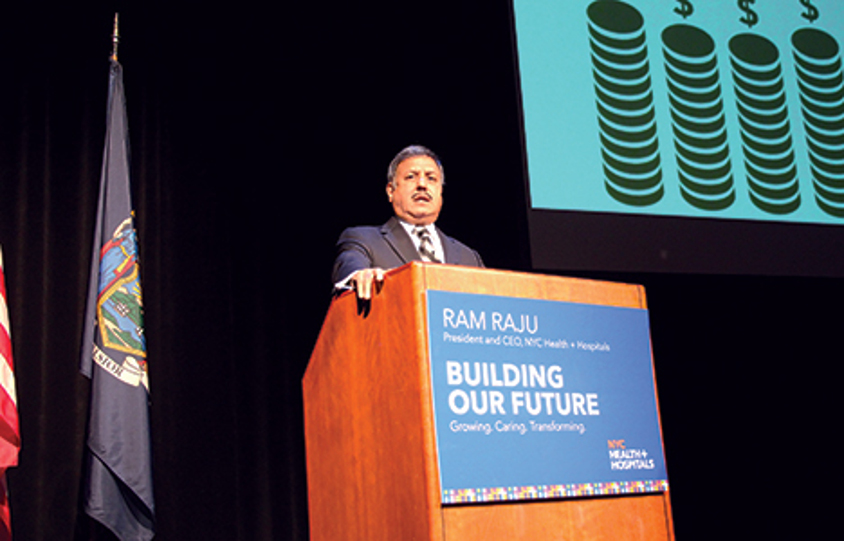Dr. Ram Raju Highlights Progress Made Toward Transforming the City's Essential Public Health System
Rallies Staff Toward Plan to Bring Financial Stability to NYC Health + Hospitals
Jan 11, 2016

Dr. Ram Raju, President and CEO of NYC Health + Hospitals, today announced progress toward a number of reforms that support the five-year Vision 2020 plan he announced last April and outlined 16 major initiatives underway to build the foundation for growth and long-term financial stability for the City’s essential public health care system that serves one in every six New Yorkers.
- Related Articles
- Official transcript of public address
The Vision 2020 plan is a strategy to transform the health system and allow it to better compete in the changing health care landscape, and when financial support is decreasing for care for uninsured patients. It is focused on bringing excellence in patient experience, expanding access to services to New Yorkers who are not connected to health care, and reforming the organization’s structure to become more efficient, moving from a hospital-centric operation to one that emphasizes prevention and wellness.
Dr. Raju returned to John Jay College of Criminal Justice – where he announced the 2020 plan – to address these reforms before hundreds of NYC Health + Hospitals employees, labor partners and other community stakeholders.
“To manage our financial issues we have only two options,” Dr. Raju said. “We can shrink our system and cut our essential services to make up for the loss of federal support. Or, we can build our system and replace lost federal dollars with revenue that we’ll generate by offering expanded services, better services, more cost-effective services to a larger patient base,” said Dr. Raju. “I am proud that we have settled on the growth option.”
Dr. Raju announced the following indicators of progress the system has made in the last year toward achieving the 2020 Vision goals:
In the last year reforms at NYC Health + Hospitals include:
- Reduced wait time for patients entering the system, and cut the wait in adult medicine by 12 days;
- Reached goals to lower the wait for a pediatrics appointment to 5 days or less at many health centers;
- Increased inpatient satisfaction scores by 6 points;
- Made health care more convenient to patients and their families and is now open later at night and on Saturdays at many neighborhood health centers;
- Launched primary care center expansion as part of Mayor de Blasio’s “Caring Neighborhoods” initiative and will build five new health clinics, and expand six existing clinics in underserved neighborhoods;
- Extended Metro Plus to all employees of the City of New York, and to residents of Staten Island for the first time;
- Eliminated the health system’s outdated organizational networks and will replace them with a simplified structure that will achieve more efficiencies and allow the system to be more responsive to patient and community needs;
- Secured $1.2 billion in state Medicaid reform funds under DSRIP to lead health care transformation in NYC and support care that reduces unnecessary hospitalizations and better coordinates care at the community level;
- Launched a new brand for the health system that visually unifies more than 70 patient care locations and represents a transition to wellness-focused health care;
- Will go live, on time and on budget, with a new state-of-the-art Electronic Medical Record system, to be first implemented in April in the health system’s Queens and Elmhurst hospitals.
“Each of these advances indicate progress, although their financial impact will take time,” said Dr. Raju. “What’s significant today is that they indicate our transformation from a provider-centered focus to one that places patients at the center of all that we do.”
In an effort to help the workforce understand the numerous, complex initiatives that are building the foundation for reform across the health system, Dr. Raju referred to them as pieces of a puzzle and explained how the pieces connect and are aligned with the 2020 agenda.
“Each is critically important in its own way to our survival,” said Dr. Raju. “They’re all system-wide and complex. It’s essential that we understand how these initiatives will connect with each other to create something that is greater than the sum of their parts. They all involve thinking differently, acting differently and looking differently.”
Contact: Ian Michaels, 347-327-1793
About NYC Health + Hospitals
NYC Health + Hospitals is the largest public health care system in the nation with a network of 11 hospitals including six regional trauma centers, community-based health centers, nursing homes, post-acute care centers, and a correctional health services unit. The system includes a home care agency and a health plan, MetroPlusHealth. The health system provides essential services to 1.2 million New Yorkers every year in more than 70 locations across the five boroughs. Its diverse workforce of more than 42,000 employees are uniquely focused on empowering New Yorkers, without exception, to live the healthiest life possible. Visit nychealthandhospitals.org and stay connected: https://www.facebook.com/NYCHealthSystem or Twitter @NYCHealthSystem.